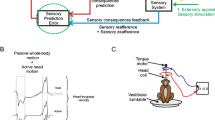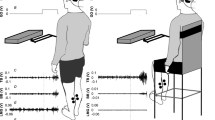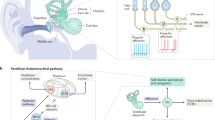Abstract
Recent studies report efficient vestibular control of goal-directed arm movements during body motion. This contribution tested whether this control relies (a) on an updating process in which vestibular signals are used to update the perceived egocentric position of surrounding objects when body orientation changes, or (b) on a sensorimotor process, i.e. a transfer function between vestibular input and the arm motor output that preserves hand trajectory in space despite body rotation. Both processes were separately and specifically adapted. We then compared the respective influences of the adapted processes on the vestibular control of arm-reaching movements. The rationale was that if a given process underlies a given behavior, any adaptive modification of this process should give rise to observable modification of the behavior. The updating adaptation adapted the matching between vestibular input and perceived body displacement in the surrounding world. The sensorimotor adaptation adapted the matching between vestibular input and the arm motor output necessary to keep the hand fixed in space during body rotation. Only the sensorimotor adaptation significantly altered the vestibular control of arm-reaching movements. Our results therefore suggest that during passive self-motion, the vestibular control of arm-reaching movements essentially derives from a sensorimotor process by which arm motor output is modified on-line to preserve hand trajectory in space despite body displacement. In contrast, the updating process maintaining up-to-date the egocentric representation of visual space seems to contribute little to generating the required arm compensation during body rotations.








Similar content being viewed by others
References
Adamovich SV, Archambault PS, Ghafouri M, Levin MF, Poizner H, Feldman AG (2001) Hand trajectory invariance in reaching movements involving the trunk. Exp Brain Res 138:288–303
Angelaki DE (2004) Eyes on target: what neurons must do for the vestibuloocular reflex during linear motion. J Neurophysiol 92:20–35
Berthoz A, Israël I, Vieville T, Zee D (1987) Linear head displacement measured by the otoliths can be reproduced through the saccadic system. Neurosci Lett 82:285–290
Bloomberg J, Melvill Jones G, Segal B (1991a) Adaptive plasticity in the gaze stabilizing synergy of slow and saccadic eye movements. Exp Brain Res 84:35–46
Bloomberg J, Melvill Jones G, Segal B (1991b) Adaptive modification of vestibularly perceived rotation. Exp Brain Res 84:47–56
Blouin J, Bridgeman B, Teasdale N, Bard C, Fleury M (1995) Visual stability with goal-directed eye and arm movements toward a target displaced during saccadic suppression. Psychol Res 58:169–176
Bresciani J-P, Blouin J, Popov K, Bourdin C, Sarlegna F, Vercher J-L, Gauthier GM (2002a) Galvanic vestibular stimulation in humans produces online arm movement deviations when reaching towards memorized visual targets. Neurosci Lett 318:34–38
Bresciani J-P, Blouin J, Sarlegna F, Bourdin C, Vercher J-L, Gauthier GM (2002b) On-line versus off-line vestibular-evoked control of goal-directed arm movements. Neuroreport 13:1563–1566
Bresciani J-P, Blouin J, Popov K, Sarlegna F, Bourdin C, Vercher J-L, Gauthier GM (2002c) Vestibular signal contributes to the online control of goal-directed arm movement. Curr Psychol Cogn 21:263–280
Britton TC, Day BL, Brown P, Rothwell JC, Thompson PD, Marsden CD (1993) Postural electromyographic responses in the arm and leg following galvanic vestibular stimulation in man. Exp Brain Res 94:143–151
Brodal A (1981) Neurological anatomy in relation to clinical medicine. Oxford University Press, New York
Day BL, Sevarac Cauquil A, Bartolomei L, Pastor MA, Lyon IN (1997) Human body-segment tilts induced by galvanic stimulation: a vestibularly driven balance protection mechanism. J Physiol (Lond) 500:661–672
Desmurget M, Pélisson D, Rossetti Y, Prablanc C (1998) From eye to hand: planning goal-directed movements. Neurosci Biobehav Rev 22:761–788
Desmurget M, Grea H, Grethe JS, Prablanc C, Alexander GE, Grafton ST (2001) Functional anatomy of nonvisual feedback loops during reaching: a positron emission tomography study. J Neurosci 21:2919–2928
Gauthier GM, Robinson DA (1975) Adaptation of the human vestibuloocular reflex to magnifying lenses. Brain Res 92:331–335
Glover S, Dixon P (2001a) Dynamic illusion effects in a reaching task: evidence for separate visual representations in the planning and control of reaching. J Exp Psychol Hum Percept Perform 27:560–572
Glover S, Dixon P (2001b) Motor adaptation to an optical illusion. Exp Brain Res 137:254–258
Glover S, Dixon P (2002) Ebbinghaus illusion in grasping: support for a planning/control model of action. Percept Psychophys 64:266–278
Golledge RG (1999) Wayfinding: cognitive mapping and spatial behavior. Johns Hopkins Press, Baltimore
Guedry FE Jr, Stockwell CW, Norman JW, Owens GG (1971) Use of triangular waveforms of angular velocity in the study of vestibular function. Acta Otolaryngol 71:439–448
Horak FB, Hlavacka F (2002) Vestibular stimulation affects medium latency postural muscle responses. Exp Brain Res 144:95–102
Howard IP (1982) Human visual orientation. Wiley, Toronto
Israël I, Grasso P, Georges-François T, Tsuzuku T, Berthoz A (1997) Spatial memory and path integration studied by self-driven passive linear displacement. I. Basic properties. J Neurophysiol 77:3180–3192
Ivanenko YP, Grasso R, Israël I, Berthoz A (1997) Spatial orientation in humans: perception of angular whole-body displacements in two-dimensional trajectories. Exp Brain Res 117:419–427
Ladpli R, Brodal A (1968) Experimental studies of commissural and reticular formation projections from the vestibular nuclei in the cat. Brain Res 8:65–96
Mars F, Archambault PS, Feldman AG (2003) Vestibular contribution to combined arm and trunk motion. Exp Brain Res 150:515–519
Miles FA, Fuller JH (1974) Adaptive plasticity in the vestibulo-ocular responses of the rhesus monkey. Brain Res 80:512–516
Nasios G, Rumberger A, Maurer C, Mergner T (1999) Updating the location of visual objects in space following vestibular stimulation. In: Becker W, Deubel H, Mergner T (eds) Current oculomotor research. Plenum, New York, pp 203–212
Pélisson D, Prablanc C, Goodale MA, Jeannerod M (1986) Visual control of reaching movements without vision of the limb. II. Evidence of fast unconscious processes correcting the trajectory of the hand to the final position of the double step stimulus. Exp Brain Res 62:303–311
Peterson BW, Abzug C (1975) Properties of projections from vestibular nuclei to medial reticular formation in the cat. J Neurophysiol 38:1421–1435
Pigeon P, Feldman AG (1998) Compensatory arm-trunk coordination in pointing movements is preserved in the absence of visual feedback. Brain Res 802:274–280
Prablanc C, Martin O (1992) Automatic control during hand reaching at undetected two-dimensional target displacements. J Neurophysiol 67:455–469
Raphan T, Cohen B (2002) The vestibulo-ocular reflex in three dimensions. Exp Brain Res 145:1–27
Roy JE, Cullen KE (2001) Vestibuloocular reflex signal modulation during voluntary and passive head movements. J Neurophysiol 87:2337–2357
Sarlegna F, Blouin J, Bresciani J-P, Bourdin C, Vercher J-L, Gauthier GM (2003) Target and hand position information in the online control of goal-directed arm movements. Exp Brain Res 151:524–535
Siegler I, Viaud-Delmon I, Israel I, Berthoz A (2000) Self-motion perception during a sequence of whole-body rotations in darkness. Exp Brain Res 134:66–73
Soechting JF, Lacquaniti F (1983) Modification of trajectory of a pointing movement in response to a change in target location. J Neurophysiol 49:548–564
Tunik E, Poizner H, Levin MF, Adamovich SV, Messier J, Lamarre Y, Feldman AG (2003) Arm-trunk coordination in the absence of proprioception. Exp Brain Res 153:343–355
Yardley L, Gardner M, Lavie N, Gresty M (1999) Attentional demands of perception of self-motion in darkness. Neuropsychologia 37:1293–1301
Acknowledgements
This work was supported by the Centre National de la Recherche Scientifique and by the Université de la Méditerranée. We thank Alain Donneaud for his technical assistance when building the experimental set-up, as well as Marcel Kaszap, Thelma Coyle, and Frank Buloup for programming expertise.
Author information
Authors and Affiliations
Corresponding author
Rights and permissions
About this article
Cite this article
Bresciani, JP., Gauthier, G.M., Vercher, JL. et al. On the nature of the vestibular control of arm-reaching movements during whole-body rotations. Exp Brain Res 164, 431–441 (2005). https://doi.org/10.1007/s00221-005-2263-4
Received:
Accepted:
Published:
Issue Date:
DOI: https://doi.org/10.1007/s00221-005-2263-4




